The ZF AS Tronic Family Automotive Transmissions for
All Commercial Vehicle Classes
1 Requirements for Commercial Vehicle Transmissions
Customers demand high efficiency along with increasing vehicle comfort and safety. As an independent transmission manufacturer, ZF customer needs include the needs of drivers, forwarding companies, and vehicle manufacturers.
Therefore, ZF considers the many requirements that a new transmission concept must fulfill when developing a transmission, Figure 1 .
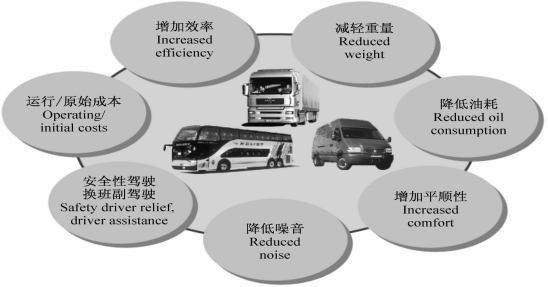

Keeping costs low is a considerable challenge, initially in terms of acquisition and later during operation. That is why fuel consumption is increasingly one of the decisive vehicle features that separate the competition. A modern transmission can make an important contribution here: On the one hand by improving efficiency and on the other hand in automatic transmissions by the optimal selection of the gear ratio dependent on the driving situation. Reducing the transmission, s weight also leads to re�duced costs: Using less material reduces acquisition costs and enabling a higher payload reduces operating costs. On the one hand, decreased oil consumption contributes to environmental protection; additionally, it has an immediate influence on the costs, however, that accrue throughout the vehicle ’ s service life.
The demand for system comfort increasingly approaches the standard set by car technology, whereas in this case limits are set by mass ratios and cost constraints. Low noise emissions are a re�sult of legal regulations on the one hand but also contribute to more comfortable driver workplaces when met. Furthermore, electronic systems increasingly support the driver and relieve him/her from routine tasks. This benefits safety in traffic.
2 Advances with Automatic Transmissions
Automatic transmissions can satisfy many of the demands that customers make on commercial vehicles considerably better than manual transmissions. Despite the fact that automatic transmissions are generally more expensive, if one takes the complete installed manual transmission system including the gearshift system into account, the difference in acquisition costs is no longer as great. Moreover, the goal of future developments is to further reduce the costs for automatic transmissions.
Even today the higher acquisition costs are already paying for themselves relatively quickly due to lower operating costs so that automatic transmissions are economically advantageous in the long run. The efficiency of the AS Tronic family of transmissions is comparable to a manual transition; however, as a rule, the shifting point selection is better due to the application of an automatic driving strategy, which positively affects fuel consumption. A long term study conducted by ZF and DEKRA found that the automatic shifting point se�lection represents the consumption performance of a very good, concentrated driver. Thus, averaging all drivers and driving situations in a commercial fleet, consumption is reduced on the order of 3 percent since the engine operates reliably in the optimum speed range with regard to fuel consumption; a process that is controlled independently of the driver, s qualification.
An additional advantage in terms of operating costs is reduced clutch wear. Reduced differential speeds during starting and shifting operations lengthen the service life of the clutch, which has al so been proven in long term tests. Many vehicle manufacturers take this into account and offer a significantly longer warranty cover on the clutch in AS Tronic transmissions.
By automating the clutch, the clutch pedal is no longer needed, which clearly simplifies operation for the driver, particularly in stop and go traffic or when maneuvering. The automatic gear selection relieves the driver from shifting as well, whereby he/she can concentrate better on road traffic. How�ever, at the same time, the driver can engage manually at any time, for instance in driving situations where the driver's forward field of vision is in question. This takes place according to Shift by Wire via an electromechanical control switch so that only very little actuating forces are applied when manually selecting gears. The rapid automatic shifting and the protection against operating error also contribute to the increase in driver comfort while at the same time protecting the transmission and driveline. In addition, the absence of a mechanical link between shift lever and transmission reduces cabin noise.
Using an automatic transmission also has advantages for vehicle manufacturers. Like the clutch control, the complete shift linkage is no longer needed, which makes both left and right hand steering vehicles easy to manufacture. When designing the driver workplace, anything is possible in terms of operating the transmission.
3 The ZF AS Tronic Family
ZF began developing automated manual trans�missions for commercial vehicles early. The first product was a partially automated transmission with automatic pre selection, which was introduced into the market in 1984. Ten years later, an automated transmission followed with the introduction of the first AS Tronic; however, the driver still had to select gears. Its successor model was first equipped with an intelligent shift program, which has been in production since 1998. Thus, a fully automatic solution was offered in a heavy commercial vehicle for the first time.
The chosen transmission concept for AS Tronic resulted in the most efficient solution possible for larger volumes. Extensive integration and removal of unnecessary components opened up potential cost savings. As a group drive, AS Tronic is designed with an unsynchronized basic transmission and synchronized splitter and range change group, Figure 2.

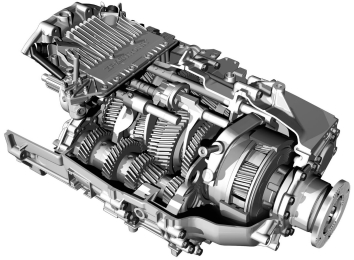
In order to reduce the weight of the transmis�sion, a design with two countershafts was chosen, which is optimal in this performance class in terms of weight. Due to a modular design and a basic transmission with 3 or 4 speeds, l6 peed, 12 speed, and 10 speed variants could be represented.
In the basic transmission, the synchronizations were replaced with shift dogs, because the synchronization can take place by controlling the internal combustion engine in modern EDC engines. An additional transmission brake is then required for up shifts, which is located on one of the two counter shafts. A standard dry clutch is used. It is fully automatic so that a clutch pedal is no longer necessary. All automated components are pneumatically operated and are combined within modules that are integrated into the transmission housing. The coordinated operation of transmission, clutch, and engine takes place by electronic control, which is located in the shift module. The interfaces to the out side were minimized.
AS Tronic was initially limited to torques of 2, 300 Nm (12 speed) and 2, 600 Nm (16 speed). Afterward, variants were introduced in a two step de�velopment, which expand the torque ranges of 12 speed transmissions upwards. AS Tronic is offered in direct drive and overdrive designs and is generally available with an integrated secondary retarder “Intarder. ’’
Automatic transmissions have found increasing acceptance in heavy commercial vehicles in the past few years and enjoy enormous popularity among customers. However, the advantages of these transmissions are also demonstrated especially in light and medium duty commercial vehicles. Vehicles in these classes are primarily used in city and regional traffic. Relief from operating the transmis�sion and the clutch is especially important in this case because the traffic environment requires the driver’s full attention. Furthermore, this sector is marked by a high number of untrained drivers and frequent driver turnover. Therefore, reducing the driver's influence on fuel consumption and clutch wear is an unmistakable advantage, not to mention safeguarding against transmission and clutch damage caused by the driver.
For these reasons ZF decided to expand the product portfolio for automatic transmissions sys�tematically into the area of low torques, Figure 3.
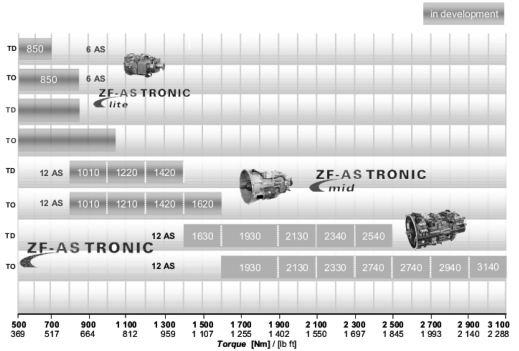

Starting from the technical fundamental principle- two pedal solutions with automatic shifting and a customer benefit that is commensurate with the AS Tronic- smaller AS Tronic transmission will be developed as well. They receive additional coding to their genuine designation in order to mark their as�sociation to the respective vehicle applications. AS Tronic mid will be used for applications from 800 Nm to 1, 600 Nm; AS Tronic lite will cover trucks in the lower torque range up to 1, 050 Nm with 6 speed transmissions.
4 ZF AS Tronic mid
The vehicle sector where the AS Tronic mid series will be used is very sensitive to price and highly differentiated in terms of application types. Thus, midrange vehicles will service both distributor and long distance transport as well as construction sites. Therefore, one of the focal points of development lies in a cost effective design that will fulfill the many and diverse customer requirements easily and also cover the wide torque range.
Consistent product planning led to the development of an uncompromising midrange transmission series designed for automation. It encompasses seven transmission types combined into one modular design. With 840 mm short and 900 mm long transmission variants, the modular design concept is primarily based on the variation of the wheel widths in order to cover the torque ranges up to 1, 200 Nm and 1,600 Nm respectively. Both transmission lengths will be offered in direct and overdrive de signs. Compared to the AS Tronic, the AS Tronic mid transmissions are approx. 50 to 65 kg lighter. In order to optimize costs, a consistent complexity management system was pursued. Approximately 40% of the components were taken from existing transmissions in production at ZF.
In order to offer uniform automation technology for all commercial vehicles in the midrange and heavy duty sectors, the proven AS Tronic components such as transmission/clutch actuators, electronics, and software were used. Due to the inter face equality this achieved, the vehicle manufacturer can offer both AS Tronic and AS Tronic mid series in almost identical vehicles with various drive line variants at minimal expense.
In a preliminary concept study, various gear set concepts were considered. Eight gear set formulas were compared using eleven selected evaluation criteria in terms of function, costs, and deadline. In order to provide this complex decision matrix with the necessary transparency, a decision making software tool was used. The choice was made for a 12 speed gear set (2x3x2), which is comparable to a conventional 9 speed gear set in terms of design space and weight and even has advantages compared to a 10 speed gear set, Figure 4.

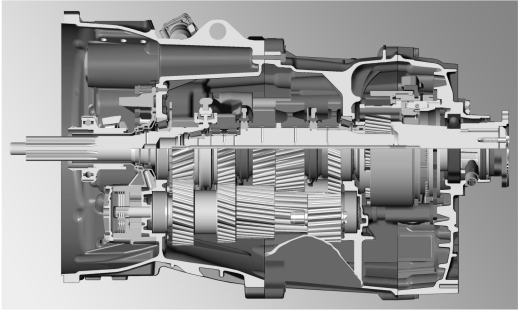
It consists of engaging and disengaging input constants ( splitter group), 3 speed main transmission, and an output end planetary drive stage (range change group). Synchronizations are used in the splitter and range change group; the main transmission shifting ele�ments are designed as dogs. The gear steps has a slightly progressive gear interval due to a small increase in the gear ratio. Thus, at a total gear spread of approx. 12. 8, the gear ratio of 23. 8 % from 11th to 12th speed is on par with a comparable 16 speed transmission. For the first time, the gear ratio of the reverse gear was designed 13. 1, i. e. slower than 1st gear on a range change group transmission by an offset engagement over the reverse idler gear. In close cooperation with the customers, high drivability was already emphasized in the specification phase. Upon completion of the rough design, the drivability release criteria of one customer were already proven in simulations.
A detailed cost analysis of the gear units in ZF transmissions led to the design of the planetary rear mounted range change group in the AS Tronic mid,in which the most cost effective solutions were adopted in each case. Thus, the design of the new gear unit is marked by the synchronization of the AS Tronic and the gear set design of the Ecosplit Figure 5.

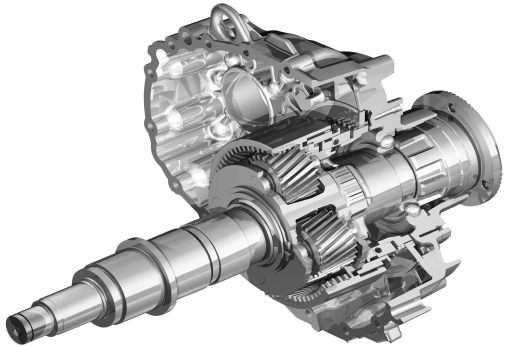
The bearings of the swing fork in the range change group are realized between the two housing parts, which minimizes seal points to the outside and possible corrosion weak points. The clutch actuating cylinder was turned in driving direction from the 6 o’ clock position for AS Tronic to the 8 o'clock position for AS Tronic mid. This not only increases vehicle road clearance and brings the actuating cylinder out of the danger zone, it al so offers the flexibility to react to potential requirements pushed clutch release under compression.
Different from the AS Tronic, the AS Tronic mid gear set will only be designed with one counter shaft. The solution was the best in a parameter study for the torque range considered, which takes into account both the modular design aspects as regards optimal gear set length variation as well as the legally permitted noise requirements. As a result, the developer faced an additional challenge. If the oil pump and transmission brake are each driven by one countershaft in the AS Tronic, then both components now must be combined in a joint, cost effective brake pump module.
Maximizing transmission efficiency in order to reduce fuel consumption attracted much interest during development. By consistently changing splash lubrication to injection lubrication, quasi dry sump lubrication was achieved so that diving losses do not occur. In order to optimize the lubrication system, oil flow calculations were conducted. The oil itself was handled like a structural/ design element. ZF has worked intensively for years with lubricant manufacturers in order to develop synthetic oils such as the ZF Ecofluid M, which is used in these transmissions. This oil has low viscosity and therefore contributes low internal losses; however, at the same time it offers sufficient lubricating film to guarantee the service life of gears, bearings, and synchronizations. An additional advantage of Ecofluid M is high stability, which makes clearly longer oil change intervals possible and greatly reduces oil consumption.
Shift dogs in the main transmission and a com pact transmission design with small center distance also contribute to loss reduction. All these meas�ures together increased the efficiency in the direct gear from 99. 2 to 99. 6% under comparable operating conditions. Active heat management enabled additional fuel savings. If the transmission runs at approx. 60℃ oil sump temperature on road, the oil viscosity can be further reduced by additionally heating to 80℃. In this case, AS Tronic mid is optionally available for the addition of a highly integrated heat exchanger. Short payback periods of approx, one year are ensured by cost effectively integrating the heat exchanger cartridge with the integrated bypass valve in the oil circulation on the intake side.



